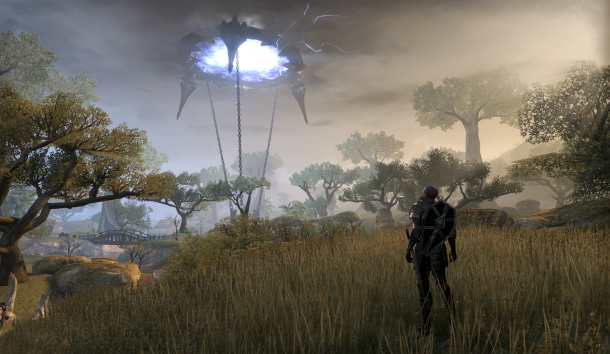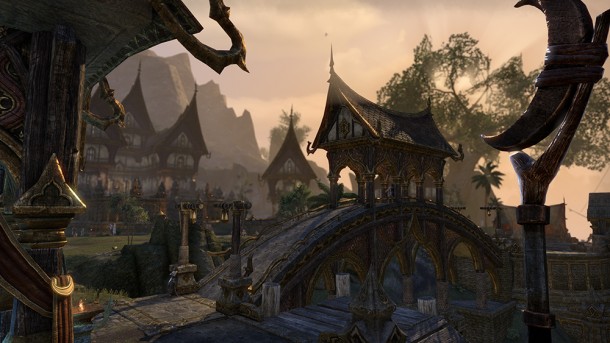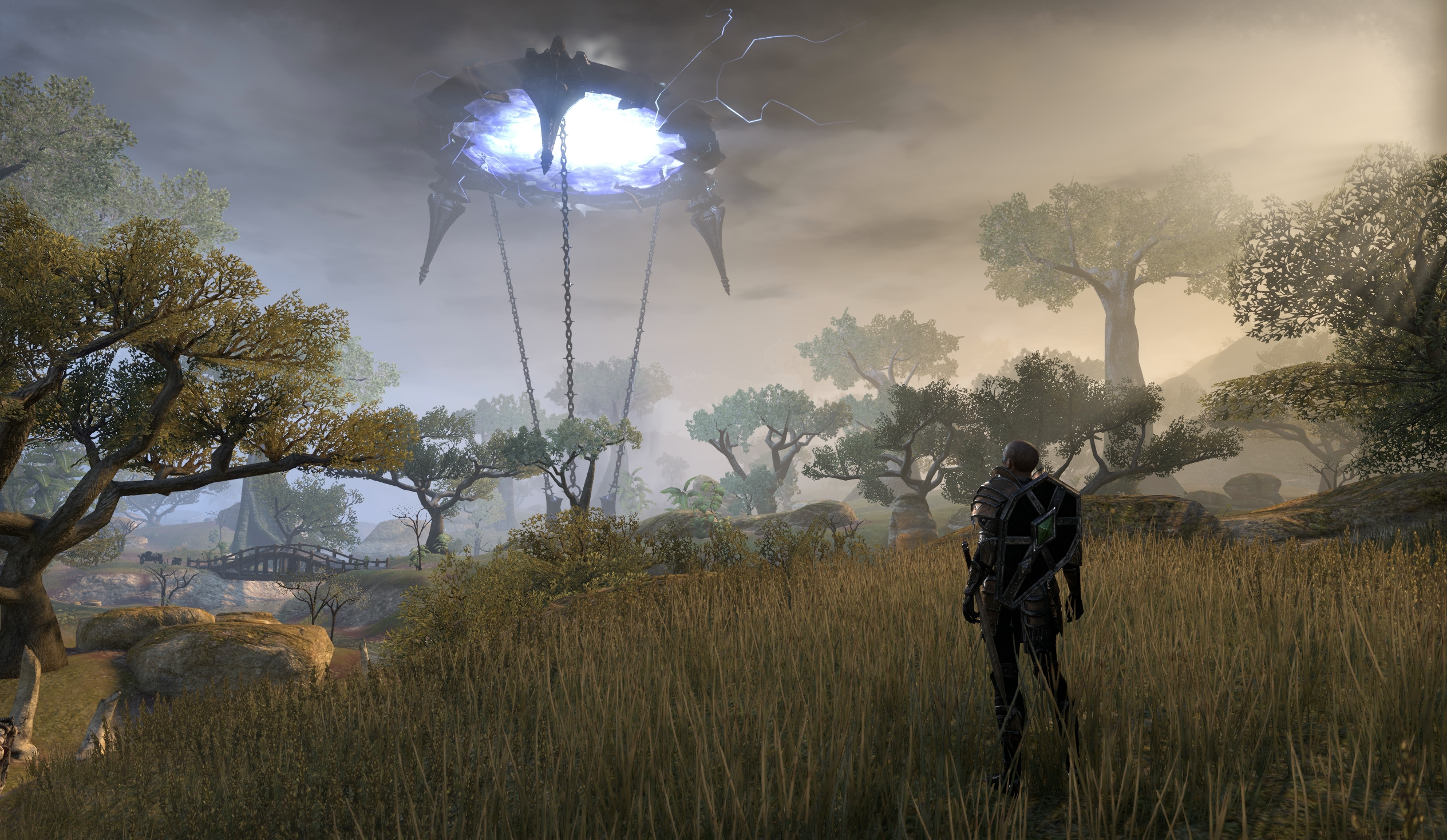
The Elder Scrolls Online begins in a prison, continuing a tradition that started with Morrowind and continued in Oblivion and Skyrim. In each of these games, players begin as a convict and must find a means of escape from their persecution. It’s also an apt metaphor for the series at large—a meditation, of sorts, on how the games strip down the confining walls of linear gameplay and introduce players to a truly open and rich world. It is only fitting that this metaphor persists in ZeniMax’s own foray into Tamriel. As an MMORPG, ESO aims to break down an entirely different set of walls: those separating the series’ single-player elements from the standard MMORPG formula. The result of this “prison-break” is a truly gratifying blend of both genres.
The prison in which players find themselves is none other than that of Coldharbour, the plane of Oblivion under the rule of Molag Bal. At the game’s outset, the player character has already been sacrificed to Molag Bal and forced to become one of the Daedric Prince’s captives. Escaping from Coldharbour hinges on the aid of a wizened and blind old man known as The Prophet. This is the first time that players learn of their purpose: they are the Vestige, an individual destined to seek out Molag Bal’s agents and loosen his hold on Nirn.
Where the Vestige goes next is determined by their alliance. The Daggerfall Covenant, the Aldmeri Dominion, and the Ebonheart Pact are associated with three races each. Depending on what the player selects during the character creation screen, the Vestige may find themselves dropped unceremoniously upon their heads in the frigid lands of Skyrim or the tropical shores of Elsweyr. Each alliance features its own story arc, and each region is endangered by unique agents of Molag Bal. These enemies’ attempts at usurpation range from covert assassination attempts to outright acts of war, and this allows for a satisfying range of gameplay as a result.

Though newcomers to Tamriel will have no trouble adjusting to the rich setting, The Elder Scrolls Online especially indulges veterans through the loving attention it pays to the source material. Each quest captures the broader strokes of the old games’ atmosphere—the dark and often macabre humor, the desperation of hard times and unforgiving environments. Occasionally, tentative piano notes will wax nostalgic and flirt with familiar melodies like the Dragonborn theme from Skyrim. At other points, ESO is far more overt in its reminiscence; it often sends players to familiar cities from older entries in the series, or it may jettison them straight into Oblivion to test their mettle against Sheogorath and his latest “pet.”
Single-player quests make ESO feel like a spiritual successor to Skyrim and its predecessors. With each new region, players are almost immediately inundated by quests, all of which are indicated by an arrow over the head of the quest giver. For these most part, these quests feature both major and minor story arcs that are as engaging as any in Skyrim. Thwarting an assassination attempt elevates players to the position of Queen Ayrenn’s confidant and agent. Completing guild quests develops a sense of rapport between players and NPC guild masters, regardless of how many other guilds the player is a part of. Fending off an attack from militant hostiles leaves casualties in its wake, but it nevertheless gives players a strong sense of accomplishment. Though these moments are occasionally cheapened by other players swarming around NPCs and quest-givers, the game sends players into instance dungeons when it counts, allowing them to escort important NPCs alone and unperturbed by other players.
A slew of familiar mechanics also enrich the game’s solo experience. Exploring the diverse lands of Tamriel results in the discovery of new areas, which reward players for straying from the beaten path. These discoveries may reveal challenging foes, experience-boosting sky shards, or Mundus Stones (which work much like Skyrim’s standing stones). They can also divulge the location of new Wayshrines, which provide increasingly convenient means of fast travel or resurrection. The landscape is also scattered with lorebooks that give context to the political turmoil and general mishaps of Tamriel’s occupants.
Crafting continues to play a major role. Players can dabble in smithing to create more robust weaponry and armor, or they can adopt the strange habit of consuming various flora and fauna in the name of divulging their alchemical properties. A sophisticated banking feature allows players to lighten their bags and gives them access to the crafting supplies in their account from any crafting station, which drastically simplifies the game’s crafting disciplines. Players can cook food and brew beverages at campfires and fireplaces, though these provide time-based buffs rather than an instant boost of health or magicka. Truly, the only obvious missing mechanic from The Elder Scrolls Online is the option of hoarding cheesewheels, plates, and anything that players can wrap their kleptomaniac fingers around. To this end, the game limits player’s inventory to directly consumable or useful items.

At times, these features almost make it easy to forget that ESO is an MMORPG, but the game offers cooperative gameplay that is just as engaging as the solo experiences. ESO’s combat system is, by far, the biggest incentive for grouping up with a friend or guild member. The enemies of The Elder Scrolls Online demand more than brainless clicking from players. Foes have a few diverse attacks of their own, which at times call for players to interrupt or block incoming attacks in order to survive. When attacking in groups, enemy AIs will fall back or press their advantage as necessary. The challenge presented by such foes (and the general difficulty curve of a few dungeons) encourages but does not force players to group up in order to complete their quests more efficiently. Similarly, events scattered over the environment encourage similar collaboration between players. This results in impressively balanced gameplay between solo experiences and community-based gameplay—a rare trait for any MMO.
By transferring traditional Elder Scrolls mechanics to an MMORPG, ESO actually manages to improve upon age-old issues with the MMORPG genre. Unlike many MMO’s, level progression requires hardly any grinding at all. Completing quests always offer a greater experience payload than combatting enemies, and they’re consistently in abundant supply. More impressively, ESO often shies away from the dull drudgery of loot gathering quests. Instead, the game favors quests that actively require the character to assess a situation and take action accordingly. As wonderful as these unique quest formats may be, they are not entirely without flaw. The few quests that require a player to don a disguise reveal a finicky disguise system, and a few quests do lapse into the pattern of gathering so many objects or completing a task so many times.
ZeniMax’s resolution to translate the single-player Elder Scrolls series into an MMORPG was certainly an ambitious and risky move. Though its play-to-play format has been the subject of much concern, hands-on time with the game indicates the degree to which the developer’s ambitious venture is a tremendous success (and well worth the subscription fee). By remaining faithful to its source material, ESO breaks free from the more repetitive aspects of MMORPGs. The cooperative and guild features allow players to explore the alluring world of Tamriel with their closest friends like never before. This results in a game that is as devoted to its fanbase as it is to freeing itself from the confines of its genres. The Elder Scrolls Online is slated for release on April 4, 2014 for Mac and Windows PC; Xbox One and PlayStation 4 owners will have to wait until June to play.
This preview is based on a PC code sent to the reviewer by the publisher.


1 Comment